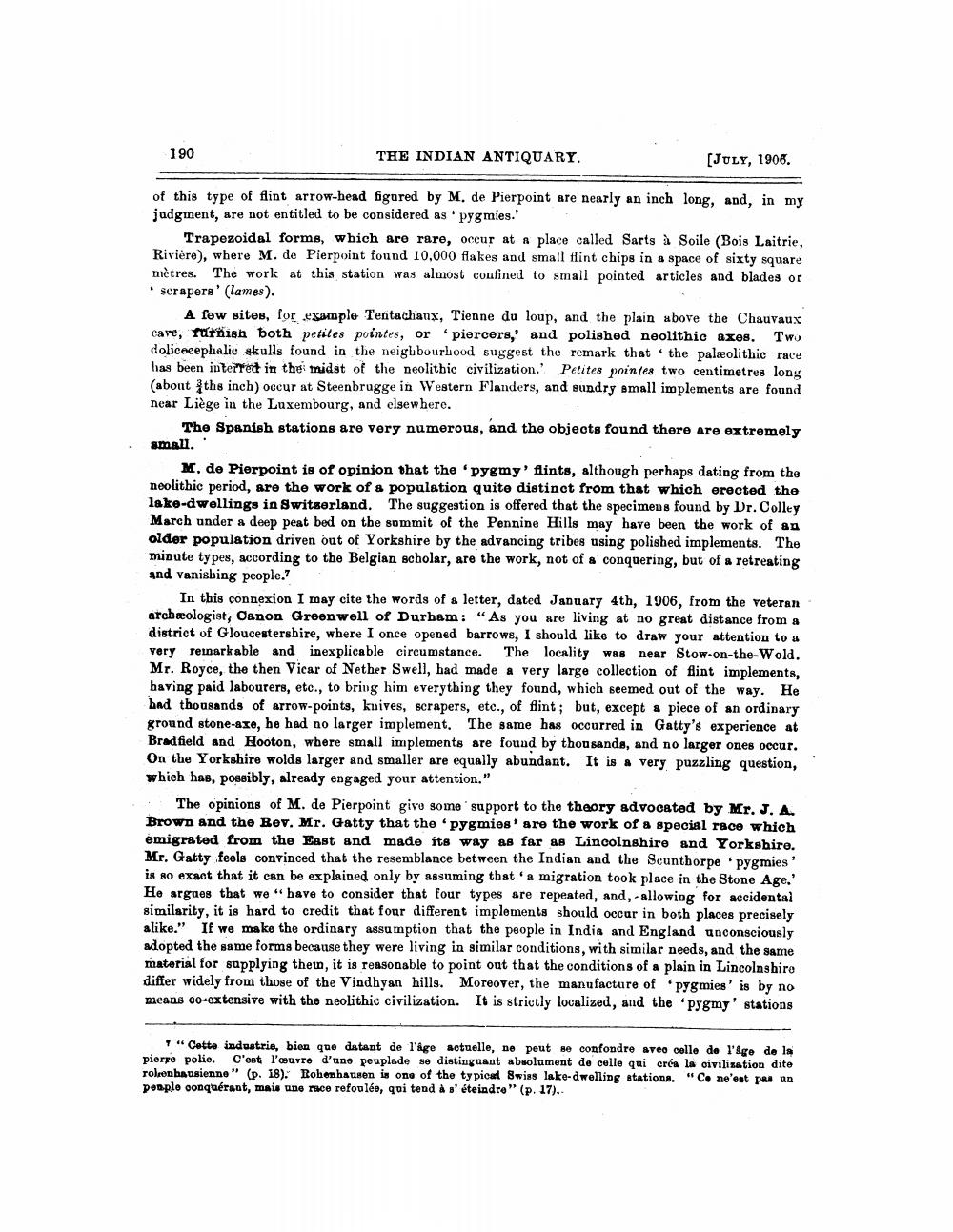________________
190
THE INDIAN ANTIQUARY.
(JULY, 1906.
of this type of fint arrow-head figured by M. de Pierpoint are nearly an inch long, and, in my judgment, are not entitled to be considered as pygmies.
Trapezoidal forms, which are rare, occur at a place called Sarts à Soile (Bois Laitrie, Rivière), where M. de Pierpoint found 10,000 flakes and small flint chips in a space of sixty square mètres. The work at this station was almost confined to small pointed articles and blades or scrapers' (lames).
A few sites, for example Tentachanx, Tienne du loup, and the plain above the Chauvaux care, rarnish both petites pointes, or piercers, and polished neolithic axes. Two doliceeephalic skulls found in the neighbourhood suggest the remark that the palæolithic race has been interred in the midst of the neolithic civilization. Petites pointes two centimetres long (about the inch) occur at Steenbrugge in Western Flanders, and sundry small implements are found near Liège in the Luxembourg, and elsewhere.
The Spanish stations are very numerous, and the objects found there are extremely small.
M. de Pierpoint is of opinion that the pygmy' flints, although perhaps dating from the neolithic period, are the work of a population quite distinct from that which erected the lake-dwellings in Switserland. The suggestion is offered that the specimens found by Dr. Colley March under a deep peat bed on the summit of the Pennine Hills may bave been the work of an older population driven out of Yorkshire by the advancing tribes using polished implements. The minute types, according to the Belgian scholar, are the work, not of & conquering, but of a retreating and vanishing people.?
In this connexion I may cite the words of a letter, dated January 4th, 1906, from the veteran archæologist, Canon Greenwell of Durham: "As you are living at no great distance from a district of Gloucestershire, where I once opened barrows, I should like to draw your attention to a very remarkable and inexplicable circumstance. The locality was near Stow-on-the-Wold. Mr. Royce, the then Vicar of Nether Swell, had made a very large collection of flint implements, having paid labourers, etc., to bring him everything they found, which seemed out of the way. He had thousands of arrow-points, knives, scrapers, etc., of flint; but, except a piece of an ordinary ground stone-axe, he had no larger implement. The same has occurred in Gatty's experience at Bradfield and Hooton, where small implements are found by thousands, and no larger ones occur. On the Yorkshire wolds larger and smaller are equally abundant. It is a very puzzling question, which has, possibly, already engaged your attention."
The opinions of M. de Pierpoint give some support to the theory advocated by Mr. J. A. Brown and the Bev. Mr. Gatty that the 'pygmies' are the work of a special race which emigrated from the East and made its way as far as Lincolnshire and Yorkshire. Mr. Gatty feels convinced that the resemblance between the Indian and the Scunthorpe pygmies' is so exact that it can be explained only by assuming that a migration took place in the Stone Age.' He argues that we have to consider that four types are repeated, and, -allowing for accidental similarity, it is hard to credit that four different implements should occar in both places precisely alike." If we make the ordinary assumption that the people in India and England unconsciously adopted the same forms because they were living in similar conditions, with similar needs, and the same material for supplying thein, it is reasonable to point out that the conditions of a plain in Lincolnshire differ widely from those of the Vindhyan hills. Moreover, the manufacture of pygmies' is by no means co-extensive with the neolithic civilization. It is strictly localized, and the pygmy' stations
7 "Cette industrio, bien que datant de l'age actuelle, ne peut se confondre avec celle de l'age de la pierye polie. C'est l'ouvre d'une pouplade se distinguant absolument de celle qui créa la civilisation dito rolenhausienne" (p. 18). Rohenhausen is one of the typicad Swiss lake-dwelling stations. "Co ne'est pas un people conquérant, mais une race refoulée, qui tend à s'éteindre" (p. 17)..




